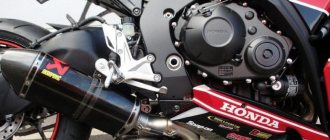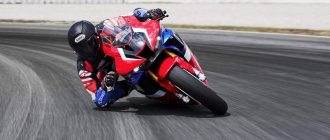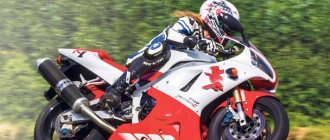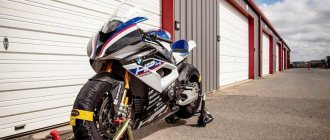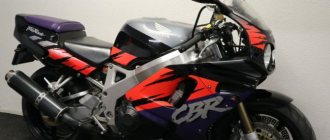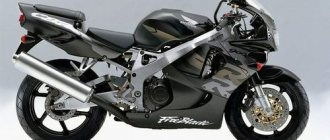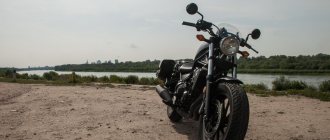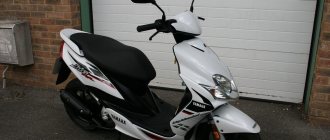The best engineers of the company were involved in the development and design of the Honda Fireblade. Based on the RC211V racing prototype, they did their best to adapt the bike to public roads without sacrificing its advantages. It was not easy to adapt the “plastic rocket” to the realities of the DOP, but the Japanese managed it! And they offered motorcyclists one of the best sportbikes in the world, powerful, reliable and at the same time obedient.
Specifications
When creating this motorcycle, Japanese engineers were guided by the experience gained while working on the Fireblade 954. They tried to improve its strengths and get rid of its shortcomings, and they succeeded, at least in part. The result is worthy of all praise - the Honda CBR1000RR's technical characteristics turned out to be very balanced, which ensured the model's incredible popularity.
Engine
During the restyling and modifications, the engine of the Honda Fireblade motorcycle was changed and refined several times, coming very close to perfection in 2021, when production of the fifth generation began. The liquid inline four 192 hp on board. and 114 Nm of torque , and its power output exceeds the 1 hp mark. per 1 kg of dry weight. The liter SBR 1000RR accelerates from 0 to 100 km/h in 2.95 seconds and reaches a top speed of 286 km/h! With the caveat that “stifled” versions of significantly lower power are sold on the Japanese domestic market.
Transmission
The 6-speed gearbox on this sportbike works quite smoothly, but you wouldn’t expect anything else from Japan’s most famous motorcycle manufacturer. True, in reviews of Honda Fireblade owners there is information about a “false neutral”, which they sometimes stumble upon while driving. Moreover, some claim that they come across it between 3rd and 4th gears, and some say about 4th and 5th. But most of the owners of this motorcycle have no complaints about the operation of the transmission. A quickshifter was added for 2021 .
Chassis and brakes
Fully customizable suspensions with a wide range of adjustments are always good. In the Honda CBR1000RR Fireblade, however, they remain rigid at any setting and are intended only for roads with good surfaces. The brakes can be called quite good, but nothing more - the feedback of the front brake (320 mm discs with 4-piston calipers) leaves much to be desired. The secondary rear brake (220mm disc with 1-piston caliper) is also mediocre. The situation is corrected by a combined ABS system , which began to be installed in 2009.
Electronics
The electronics of the Honda Fireblade have been significantly improved in the fifth generation, released in 2021. Selectable Torque Control traction control system was added . But even without it, the motorcycle has enough electronic components, which are extremely difficult to understand without a manual and dealer software.
Weight and dimensions
The curb weight of all generations of the Honda CBR 1000 RR, except the last one, exceeds 200 kg , and this is quite a lot by the standards of the class. But in 2021, the bike has undergone a number of changes, allowing the weight to be reduced to 196 kg , and this is with a full tank and all technical fluids. Subjectively, the motorcycle seems heavy, but you don’t feel it at all while driving, but rolling it around with your feet in a parking lot can be difficult.
Controllability
The Honda CBR 1000 RR motorcycle handles perfectly, and this is one of its main advantages. It behaves predictably even at high speeds, but that doesn't make it boring. Handling remains at a decent level even at speeds above 200-220 km/h, and this is largely due to good suspensions.
Fuel consumption
The declared fuel consumption per 100 km is about 6 liters . When driving on the track, it increases sharply, and in the combined cycle, according to reviews, it fluctuates around the mark of 7-7.5 liters . Considering the spacious gas tank, 17.7 liters before 2021 and 16 liters after 2021, this is enough for a decent range.
The motorcycle prefers high-octane gasoline, and it is advisable to fill it with AI-98.
On the run
Those who have read this far are definitely interested in how the RR-R behaves on the road. I, like most of my colleagues, had three 20-minute sessions in the saddle, and this, of course, was not enough to fully understand the new motorcycle, but Honda did a very smart thing: they brought the previous generation CBR1000RR SP and a couple of base models there too - for contrast, so that when changing from one motorcycle to another, it would be easier to feel the difference.
At the very first moment you can feel the difference in the fit. The track purpose is obvious from the higher saddle (830 vs. 820 mm), lower clip-ons (840, 17 mm lower) and pegs mounted 21 mm higher and 43 mm further back. You can also feel the narrowness of the transition between the tank and the seat. There's not much room to sit back, which meant my elbows ended up next to my knees (rather than in front or behind) when I lay down on the tank. And all this became clear before the engine started!
We start with the starter button (the key fob should be nearby) - and the short-stroke engine explodes, waking up, with its familiar guttural song, familiar from cubic inline fours, which the Akrapovic pipe does not so much muffle as decorate it with uterine overtones, showing that the monster has woken up and wants to freedom.
Side by side with the old CBR SP you understand a lot. One cannot say that the old Siber is clumsy - but the new one, despite the still untested design, feels as if all the positive aspects of the old one were taken and tripled!
The new engine responds quicker (but not harshly) and revs a little more aggressively than before, reaching a redline of 14,500 - higher than the old version. Powerful thrust is present throughout the entire stroke of the throttle right up to the very top, where a pleasant peak awaits - I wonder, by the way, how the American version differs? Isn't there a cutoff for traction at the top?
Honda CBR1000RR-R Fireblade SP
The quickshifter is excellent on both models, old and new , and the only misfire was my fault when I hesitantly poked down, moving (or not switching, I didn’t understand) from second to first. The biggest complaints about the old CBR were the rough and overly obvious operation of the electronic assistants - but the transition to modern Bosch components solved this problem in the most positive way.
Setting the traction control to the first, least intrusive setting, I could see it clicking through on the beautiful (but overloaded) 5-inch display. You feel it, but not in the way you expect - instead of jerking and settling, traction control allows the engine to spin exactly as it needs to in order to drive without slipping. I think professionals drive without it, taking controlled drifts on themselves, but we mere mortals can safely rely on the electronics, which work perfectly in the first position. Funnily enough, higher levels of traction control work well on the track, but in third I started to notice that it was slowing out of tight corners until the bike was back upright. So my choice is the first level, given that it was shod in Pirelli Supercorsa SP.
Yes, we drove on the track on road tires - and replaced them in the middle of the day with the same ones, although this could not have been done. Despite not having the physical grip of a good slick tire, these tires were enough to tell the difference in handling between the old and new CBR. The new one turns noticeably sharper and holds its trajectory noticeably more confidently - in other words, more stable.
Given the CBR1000RR-R Fireblade SP's longer wheelbase and slightly flatter stem and trail, this isn't surprising, but the new CBR handles just as well as its predecessor. The Ohlins electronic suspension did not cause any particular complaints either - however, I only drove in Auto mode for one run, but I was satisfied with everything. I definitely want to understand them in more detail.
On the day of the race, the weather was great, and there was no opportunity to test the electronic assistants in real conditions. But it’s nice to know that you can ride at full strength and with minimal interference - and at the same time be sure that you are covered from the wildest mistakes (which usually become fatal), including in bad weather.
Wings. Are they working? Seems to be yes.
In any case, in one place at the exit of the turn there is a slight rise, and passing it in third gear, you gain over a hundred, and after passing it, on the old CBR the front end lifts at the most inopportune moment, when you need to enter the second turn. The new CBR1000RR-R Fireblade SP never tried to lift the wheel in the same place, and the speed was slightly higher.
CBR1000RR-R Fireblade SP
Repair and tuning
The more complex and modern a motorcycle is, the more difficult and expensive it is to maintain and maintain - this is an axiom. The first generation Honda Fireblade can be serviced and repaired in a garage, but fresh examples will require dealer equipment, which even the most thrifty biker is unlikely to have.
Repair
The Honda Fireblade does not have frequent breakdowns or childhood problems. With timely maintenance, the motorcycle will ride for years, and the only problem may be the gradually increasing oil consumption . It is impossible to cope with it on your own; the only option is to replace the CPG with a new one. The Honda company also announced a recall for free clutch repairs due to a defect in this unit on motorcycles 2017+ model years, and this operation will be done for free at any dealership, but no one has yet heard of a failure due to this clutch.
Spare parts
Thanks to the extensive dealer network, there are no problems with spare parts for the Honda Fireblade, but anything more serious than consumables and small parts will have to wait, since large components are usually not available. Prices are sometimes steep, plastic is expensive, but there are inexpensive alternatives from our Chinese friends.
Tuning
Most often, the brake system - most owners find it insufficiently effective. On the first generations of the CBR 1000 RR, the steering damper is sometimes changed , but for new copies, where a modern electronic damper is already installed in stock, this is no longer relevant.
Advantages and disadvantages of a motorcycle
Among the advantages of the CBR1000 RR model, the following qualities should be noted:
- Reliable braking system.
- Dimensions standard for a sportbike.
- Quite powerful 4-stroke engine.
- High top speed.
- Stylish, modern and unique design.
- Easy to read dashboard with many adjustment functions.
- Good dynamic qualities.
- Possibility of tuning.
- Availability of parts.
The obvious disadvantages of the model were:
- The suspension is sensitive even to small road irregularities.
- High cost (400–600 thousand rubles depending on mileage and year of manufacture).
- Not suitable as a first motorcycle.
Some motorcyclists choose inexpensive equipment with average performance and quality. Others are willing to spend several hundred thousand to purchase exclusive and powerful equipment that will attract the attention of others. Are you ready to spend more than half a million to buy a Honda CBR1000 RR?
Motorcycle modifications
The Honda Fireblade comes in two versions, regular and SP . The latter is more focused on the track, as well as better technical equipment. More advanced suspensions from Öhlins, a retuned engine and stronger brakes with a combined ABS system hint that the bike is not designed for boring driving in traffic jams, but for squeezing adrenaline on the track. The Honda CBR 1000 RR SP version has been produced since 2014 in parallel with the regular modification, and costs slightly more.
Advantages and disadvantages
Strengths and weaknesses are usually directly related to the concept of the motorcycle. Honda Fireblade is a sportbike, powerful and dynamic , with all the advantages and disadvantages characteristic of racing motorcycles. It has one really serious drawback - it can be dangerous for inexperienced motorcyclists, and it can only be recommended to experienced bikers.
Advantages
- Excellent handling . The Honda Fireblade handles better than most of its analogues. All owners unanimously praise the predictability of the motorcycle’s behavior on the road.
- Excellent wind protection . The headwind does not bother you even at a speed of 200 km/h.
- Accelerating dynamics . How many motorcycles do you know that can reach 100 km/h in less than 3 seconds?
- Comfortable fit . Despite the fact that the liter Honda CBR1000RR Fireblade is in no way related to sports tourists, it is comfortable enough for long trips and even travel.
- Gorgeous pendants . A full set of adjustments is included (valid for models released in 2011 or later).
Flaws
- The brakes are insufficiently effective compared to the main competitors . Owners of the Honda CBR 1000 RR can be recommended to replace the front brake calipers with more powerful ones, especially if they like aggressive driving.
- Oily appetite . The CBR 1000 RR engine heats up noticeably, and when it overheats, scuff marks begin to appear on the cylinder walls, since the quality of the nickel-silver coating leaves much to be desired. As a result, most vehicles with a mileage of 30-40 thousand kilometers already have more or less noticeable consumption of engine oil.
- Difficult maintenance . Some operations will require scattering half a motorcycle around the garage, and even replacing an ordinary oil filter turns into an epic.
Owner reviews
The motorcycle is definitely not for beginners; if you get on this rocket without experience, it can really become disposable, as in the old joke. Honda Fireblade is not some kind of seabird, this fiend of the devil gets on the rear wheel in third gear and at a speed of about 200, and accelerates so that the clip-ons are torn out of your hands. The liter Siberian is a chic spendthrift, no doubt about it, but very demanding of experience and skills. Honda has really created a real two-wheeled demon. Anatoly, Omsk, Honda CBR1000RR Fireblade '2005.
I’ve already ridden the Fire 1000 for two seasons, before that I had a Fire 954. The bike is interesting, but not without its weak points - the suspension is stiff, purely for the track or asphalt standards, the stock front brakes are weak, the same R1 has at least 6-piston Brembos . The motor heats up like hell, especially if you push it hard; installing two fans instead of one only partially solved the problem. The oil burner is indeed present, but not critical, the main thing is to monitor the level. As far as I know, in the last generation all these jambs were eliminated, but I have Fire from the first year of production, that is, it is still damp. Dmitry, Moscow, Honda CBR1000RR Fireblade '2004.
Horse fire! I bought it new from a dealership in 2021, I drive it a little, and in three seasons I have driven a total of 12k km. I go to work by car, IMHO, in such a brutal sport, throwing up in traffic jams in a full outfit is below average pleasure, so my moto is purely for the weekend and for the track. In order to ride on business, it is better to take something quieter. Mikhail, St. Petersburg, Honda CBR1000RR Fireblade '2016.
Similar models
- Kawasaki ZX-10R . Top sportbike from an evergreen manufacturer. Top-end, because the Ninja H2 is more suitable for sports tourists.
- Yamaha YZF- . The most famous “liter” in the world, and that says it all.
- Suzuki GSX-R1000 . A reliable motorcycle that has been developing and modernizing over many decades.
Cat in a poke
To change the situation for the motor show in Cologne (Germany), which was supposed to take place in the summer of 1976, the Japanese prepared a “pig in a poke.” And they presented 2 models at once. Honda CBR600F and Honda CBR1000F. The filling of both was almost identical.
Honda CBR600F.
Honda CBR1000F.
Inline 4, steel frame, liquid cooling, as well as a number of other new parts. The only difference was the engine size.
As it turned out later, the concern killed not 2 birds with one stone, but a whole flock:
- The model was designed as an export model , and therefore residents of other countries should not have problems with size (theoretically).
- For those who consider taxes and maintenance of a liter to be unaffordable costs, an identical model is offered that rolls the same way, but requires less money for maintenance .
- And finally, dual sport . The new bikes, although considered sports, were of the sport-touring type. The comfortable fit made it possible to use the bike on long-distance trips, and its nimbleness and maneuverability were ideal for urban conditions.
The 600-cc version lived on the assembly line until 2013, the liter version went down in history at the end of 1999.
FAQ
- A liter Fireblade goes 300 km/h? Without tuning - no. Do you need it?
- I drive a 954RR, does it make sense to change it to a 1000RR? If the budget allows, of course. The Honda CBR1000RR has noticeably better technical specifications and looks much more modern.
- Is it possible to ride such a bike with a couple of seasons of experience? I drove them to a Honda CB400 . Anything is possible, but it is better to make a choice towards a motorcycle that is less provocative of cosmic speeds.
Honda CBR line
CBRs are good sportbikes for the road, with a torquey engine at medium speeds and acceptable ergonomics, but at the same time, on the track, for which the Honda CBR1000RR seems to be made, it is not impressive.
The last time a production Honda bike really got the crowd excited at a race was when Colin Edwards won World Superbike riding an RC51. This was about 20 years ago, and it wasn’t even a CBR, but a VTR. Yes, some may not know, but the RC51 is a VTR1000 SP1 (for some unknown reason, Americans know it as the RVT1000R). A couple of years later, James Toseland took the championship on a Honda CBR1000RR, but it's unlikely that any racing fan dreamed of the CBR as much as the RC51.
For more than ten years, the CBR line was not very popular. For a brand that made its name at the highest level of racing, this was unacceptable. And it's time for another R.
Conclusion
The Honda CBR1000RR Fireblade is perhaps the best sportbike from one of the best motorcycle manufacturers in the world . It is capable of competing on equal terms with such recognized track leaders as the Yamaha R1 and Kawasaki ZX-10R and the liter Jixer. Designed to win races, this bike has been very well adapted for public roads , and on city streets it feels like a duck to water, although its element is the race track. And be warned - the Honda CBR1000RR's performance is so good that it's hard to resist the temptation to see what it can do. The bike provokes aggressive riding, and while driving, you should not give in to momentary emotions.
Specifications
| Maximum engine power: | 192.0 hp (141.0 kW) at 13000 rpm (2017+), Honda Selectable Torque Control (HSTC) – 2017+ HP |
| Torque: | 114.0 Nm (11.5 kg*m) at 11000 rpm (2017+) Nm |
| Working volume: | 998 cm3 |
| Motor type (cylinder arrangement, number of strokes): | 4-cylinder, 4-stroke, in-line |
| Number of cylinders: | 4 |
| Number of valves: | |
| Intake type (Injector / Carburetor): | |
| Bore and stroke: | |
| Starting system (Electric starter, kick starter): | |
| Maximum speed in km/h: | 286 km/h |
| Cooling system: | Liquid |
| Transmission (gearbox): | 6-speed |
| Clutch (Dry / Wet): | |
| Drive unit: | Chain |
| Frame: | Aluminum |
| Chassis | |
| Suspension (front/rear travel): | |
| Brakes (Front/Rear): | |
| Wheels / Tires / Rubber: | |
| Dimensions and weight | |
| Dimensions (Length / Width): | |
| Seat height: | |
| Ground clearance: | |
| Curb weight: | |
| Wheelbase: | 1410 mm (2008-2016) mm |
| Weight: | 196 kg |
| Fuel tank capacity: | 17.7 l. |
| Battery capacity: | |
| Year of release: | |
| Country of Origin: |
